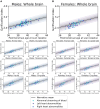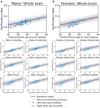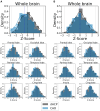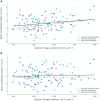Individualized cortical gyrification in neonates with congenital heart disease
- PMID: 39429246
- PMCID: PMC11487749
- DOI: 10.1093/braincomms/fcae356
Individualized cortical gyrification in neonates with congenital heart disease
Abstract
Congenital heart disease is associated with impaired early brain development and adverse neurodevelopmental outcomes. This study investigated how individualized measures of preoperative cortical gyrification index differ in 142 infants with congenital heart disease, using a normative modelling approach with reference data from 320 typically developing infants. Gyrification index Z-scores for the whole brain and six major cortical areas were generated using two different normative models: one accounting for post-menstrual age at scan, post-natal age at scan and sex, and another additionally accounting for supratentorial brain volume. These Z-scores were compared between congenital heart disease and control groups to test the hypothesis that cortical folding in infants with congenital heart disease deviates from the normal developmental trajectory. The relationships between whole-brain gyrification index Z-scores from the two normative models and both cerebral oxygen delivery and neurodevelopmental outcomes were also investigated. Global and regional brain gyrification was significantly reduced in neonates with congenital heart disease, but not when supratentorial brain volume was accounted for. This finding suggests that whilst cortical folding is reduced in congenital heart disease, it is primarily driven by a reduction in brain size. There was a significant positive correlation between cerebral oxygen delivery and whole-brain gyrification index Z-scores in congenital heart disease, but not when supratentorial brain volume was accounted for. Cerebral oxygen delivery is therefore likely to play a more important role in the biological processes underlying volumetric brain growth than cortical folding. No significant associations between whole-brain gyrification index Z-scores and motor/cognitive outcomes or autism traits were identified in the 70 infants with congenital heart disease who underwent neurodevelopmental assessment at 22-months. Our results suggest that chronic in utero and early post-natal hypoxia in congenital heart disease is associated with reductions in cortical folding that are proportional to reductions in supratentorial brain volume.
Keywords: MRI; cerebral oxygen delivery; neurodevelopmental outcomes.
© The Author(s) 2024. Published by Oxford University Press on behalf of the Guarantors of Brain.
Conflict of interest statement
The authors report no competing interests.
Figures







References
-
- Goldman-Rakic PS. Development of cortical circuitry and cognitive function. Child Dev. 1987;58:601–622. - PubMed
Grants and funding
LinkOut - more resources
Full Text Sources
